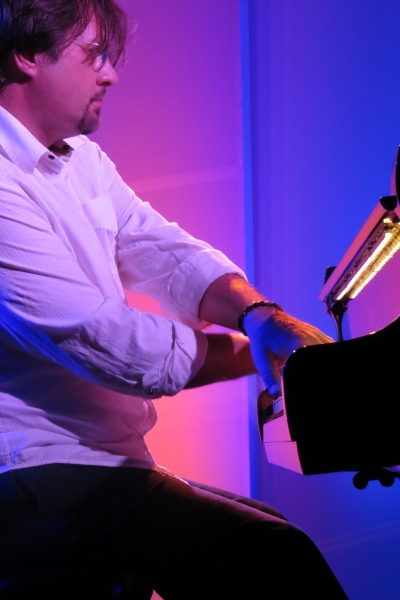I have been reviewing pianist/composer David Hicken’s music for ten years now. Over the course of that time, we’ve also become good friends. In March 2015, David and his family visited Florence, Oregon for the first time and David performed a very exciting house concert here that people are still talking about. We lost touch for a while, but I have been busy catching up with his many projects from the past year or so. I think you’ll enjoy this update to the two previous interviews, which are also available here:
February 2014 April 2008
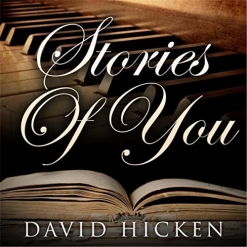
Click on album covers to go to Kathy's reviews.
KP: It’s been a little more than three years since our last interview and it appears that the past several years have been really productive for you. It’s great to be back in touch!
DH: Thanks Kathy, it’s great to be back in touch and have an opportunity to let you know what I have been working on. The last three years went by so quickly and this has been one of the most productive periods for me.
KP: Just in the past month, you have released a new album, a companion sheet music book, and a book on composing and improvising. Let’s start with the new album, Portrait of a Pianist. I assume that the “Pianist” part of the title refers to you. If the album is a self-portrait, what were you thinking of or aiming for as you were composing the music?
DH: Yes, the new album is a portrait of me, and reflects where I am currently, both as composer and pianist. My music falls into two broad categories: soft, romantic works as well as more technical, classically based pieces. My previous albums have consisted of all one style or the other, and I felt that it was time to create a more balanced collection of pieces. In a way, this album is a combination of Stories Of You and The Art Of Piano.
KP: The album is such a study in contrasts, with music that is very fast, dramatic and powerful to music that is slow and sometimes mournful. You, yourself, seem pretty even-tempered and calm. Is this portrait more about your inner self?
DH: When I sit down to compose, I never know what will come through my fingers, because I rarely begin with any particular idea in mind. I am always searching for combinations of notes which I find pleasing first and foremost. My music is not a reflection of my mood at any given time, and some of the saddest music that I’ve written came to me at times when I was extremely happy. I believe that a culmination of life experiences helps to shape a composer’s work on a subconscious level, so although there may be parts of my inner self reflected in the music, it is not deliberate.
KP: Hmmmm! Very interesting! You have been calling your music “classical crossover” for several years now, but I think this new album really embodies the spirit of classical crossover. Did you intentionally take your new music in a more classical direction or has it been more of a natural evolution?
DH: It was actually a little of both. My album
Faeries was already moving in a slightly more classical direction with elements of Liszt and Schumann in tracks such as “Rhoslyn,” “Oberon” and “Lorelle.” However, I deliberately decided to make my music more intricate by incorporating elements of my organ playing into new compositions. After many experiments, the first idea that I really liked was “The Rhapsodist,” and it was this piece that helped to propel my work in a completely different direction. Around the same time, I also came up with the initial ideas for “Incantation,” but ended up using those ideas in “The Bell Carol” first. After seeing the popularity of “The Bell Carol,” I knew that it was time to revisit the other pieces, and so
The Art Of Piano was born.
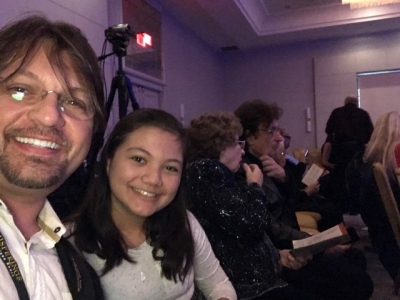
David and his daughter, Anna, at Whisperings 2017.
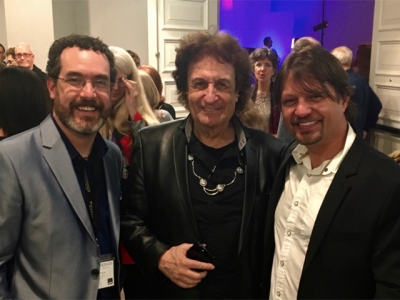
Neil Patton, Patrick Moraz, and David at Whisperings 2017.
KP: Not everyone knows that you were originally a top organist and that the organ was your primary instrument for a long time. Did you start out on the piano and move over to organ or was the organ your first instrument?
DH: I began piano lessons at the age of three and took up organ lessons when I was twelve. The organ was indeed my primary instrument throughout most of my career, and I have been fortunate enough to have given recitals on some of the finest instruments in the world. After playing most of the organ repertoire that I loved, I found myself gravitating back to the piano. The organ is a magnificent instrument, but it does not have the expressive qualities of the piano, and as a composer, I felt that I could accomplish more on the piano than on the organ. However, there are many times that I wish my piano had a pedalboard, because I would be quite comfortable using both feet in addition to my hands.
KP: Your mother has been a piano teacher as well as the principal of a large school. Does she play organ, too? Did she teach you piano and organ or just get you started on the piano?
DH: My mother is primarily a pianist, although her duties as Director of Music did mean that she had to play the organ occasionally. She taught me piano until the age of twelve, at which time I began organ lessons with a visiting teacher at my school and continued my piano lessons with another wonderful piano teacher in town.
KP: Okay, let’s talk about some of the pieces on Portrait of a Pianist. Were you intentionally paying homage or tribute to JS Bach on “Espionage” and some of the other faster pieces on the album?
DH: Clearly, Bach is my hero, and I cannot even begin to explain the profound impact that his music has on me. I like to include a
contrapuntal section in many of my faster pieces, and the style does tend to lean more towards Bach than other Baroque composers such as Handel, Telemann or Vivaldi. I’m sure it’s because I have played so many of Bach’s preludes and fugues, toccatas and fugues, chorale preludes etc., but also probably because my studies in harmony and counterpoint included so much of his work. As soon as I came up with the opening theme for “Espionage,” I knew that it should feature imitation, just like that of a two-part invention, and I even considered making it into a three-part fugue. As it continued to develop, I could clearly hear the influence of Bach, and although I didn’t set about writing a piece as an homage to him, I feel that in the end, that’s what it became. It is definitely one of my favorites to play.
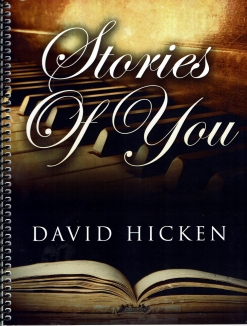
Click on covers to go to Kathy's reviews.
KP: Mine, too! I absolutely love “Fountains Abbey.” What inspired that piece (or the title)?
DH: The opening theme, although somewhat melancholy, has as rather stately nature about it. Images came to me of a ruined abbey that was only a shadow of its former self, and I thought of “Fountains Abbey,” a Cistercian monastery built in 1132 and destroyed by Henry VIII in 1539, which I had visited in my youth. It is a marvelous place, because although it is sad to see something that was once so magnificent fall into ruin, it is still beautiful and magical.
KP: What about “A King’s Ransom”? That piece feels so visual and like it’s telling a story.
DH: The piece certainly does take the listener on a journey, and my aim was to keep the piece exciting and yet interesting throughout. It’s all too easy to repeat a section of music several times, so I wanted to weave one idea into the next as seamlessly as possible. When the original idea returns, it moves to a higher key to create a sense of tension.
KP: What was the inspiration for “Valhalla”? That’s one of my favorites in the songbook.
DH: The piece is rather menacing right from the beginning and evokes images of warriors and heroism. I have always been interested in old Norse legends, and the fact that Valhalla is a majestic hall ruled by the god Odin and is the ultimate goal of Viking warriors, it seemed like a perfect title.
KP: What gave you the idea to combine “Canon in D” and “Ode to Joy” into a medley?
DH: As an organist, I played “Canon in D” for countless weddings, and “Ode to Joy” was one of the most popular hymns for church services. A few years ago, it occurred to me that the melodies would probably fit together, not just as a medley, but at the same time, one on top of the other. I revisited the idea just for fun, and this arrangement was born. It is one of the top-selling items on my website.
KP: The companion sheet music book for Portrait of a Pianist is quite challenging. Do you get many requests for help and suggestions for how to play some of the difficult passages?
DH: I receive emails almost every day regarding technical issues in my pieces. Questions run the gamut from correct fingering, hand position, how to develop speed and stamina, as well as dynamics, pedaling and interpretation. Many pianists find my videos very helpful when learning these pieces, because they can see much of what I’m doing. One of the things that I stress is that the pieces don’t have to be performed exactly as I do, and they certainly don’t need to be as fast.
KP: Whew! That’s a relief! You also released a new book, Secrets to Better Composing & Improvising, in the past week. I just received my review copy and should have a review posted before the end of March. Please give us a brief overview of what is in the book.
DH: Many people have written to me saying that they would love to compose music, but just don’t know where to begin. Although there is a plethora of books on harmony, counterpoint, orchestration, music theory, form in music etc., it is all overwhelming for someone who is just starting out. My aim was to write a book that explained as many different elements of the composing process as possible, and put it into layman’s terms. Although composition can’t be taught and must be learned, I have written about many of the techniques used in traditional composing which can help people to write any style of music.
KP: I don’t quite understand “composition can’t be taught and must be learned.” There are plenty of composition classes and books out there. Do you feel that taking classes is a waste of time?
DH: One learns to compose by constantly experimenting with combinations of notes and sounds, and discovering along the way which combinations are pleasing or not. Classes and books are useful and very necessary for pointing out certain rules and pathways, but composition is truly learned by doing. Education is always valuable, but many modern courses in composition lean too heavily on serialism and atonality which are of no use to the majority of aspiring composers.
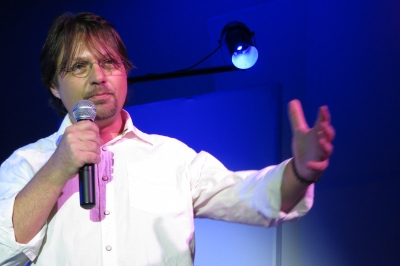
David introducing "Kaiaka Bay" at Whisperings 2017.
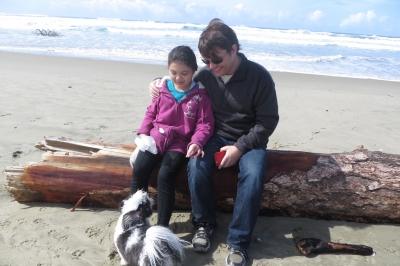
David, Anna, and Kono in Florence, OR March 2015
KP: Okay - that makes sense. A few months ago, you released The Ultimate Piano Workout. It looks like that book is mostly scales and arpeggios with some explanatory text. Can you give a brief synopsis of that book? (I will also be reviewing that one shortly.)
DH: One of the most common questions I receive is about technique, and over the years I have responded to hundreds of emails, always with the same message of “learn and master your scales.” Although I played the studies of Czerny, Hanon, Burgmüller and countless other composers, I attribute my technique solely to the diligent study of scales and arpeggios, and anyone can develop the same technique by working on them. The next question I have received most often is usually about what type of scales to play as well as which books are the best, so I set about writing my own book which details all of the scales that I play, as well as the order in which to learn and play them. I developed a 30-minute routine that allows me to cover all scales and arpeggios over the course of three days and the book explains how to work up to that as an ultimate goal. I also explain in detail about why scales are so important in helping to understand tonality, which in turn, helps with sight-reading and learning new pieces.
KP: When you originally released your first three solo piano albums in 2007 and 2008, you were known mostly as a “new age” (whatever that means!) pianist. Over the past few years, you’ve been moving away from that genre and identifying more as a “classical crossover” artist. Isn’t it more difficult to reach classical music fans?
DH: Yes, it is much more difficult to reach fans of classical music because they are very particular. They tend to have very fixed view of what falls into the “classical” category, and are often not very accepting of anything modern. My faster pieces are generally too heavy to fit into the new age genre, and yet, despite its classical roots, my music does not fit into the classical genre either. “Classical crossover” refers to a style of music that is somewhere in between and can appeal to listeners who sometimes find classical music a little too serious, or new age music a little too mellow. I like to think of my music as film music without any attachment to visual images, and film music is a better descriptor, albeit one that I cannot use.
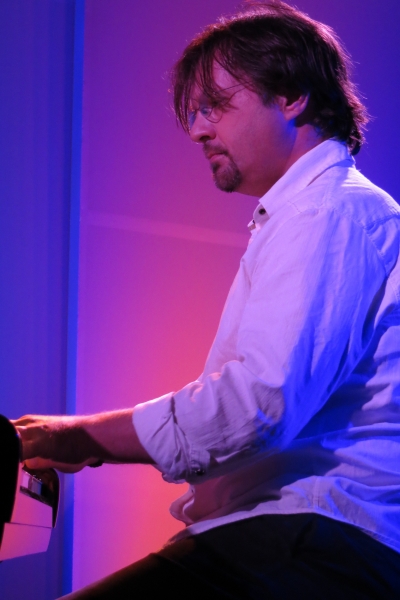
David performing at Whisperings 2017.
KP: Last year’s release, Stories of You, is definitely more on the mellow side and was nominated for the 2016 Album of the Year on Whisperings Solo Piano Radio. Are any of the quieter tracks on Portrait going to be played on Whisperings?
DH: Some of the quieter tracks are similar in style to those of Stories Of You, so I certainly hope that they will be played on Whisperings.
KP: Let’s talk some more about the two albums you released last year (2016). The Art of Piano is so different from your earlier albums. Most of the pieces are fast, high-energy, and very dramatic. What inspired you to go in such a different direction?
DH: As mentioned earlier, it all began with “The Rhapsodist.” I deliberately set about writing something more complex than Goddess, Angels and Faeries, and it took a while to come up with ideas that I liked. When the ideas for “The Rhapsodist” came to me, I was very excited and knew that I wanted to continue in that direction. I became very busy in other areas of my life, and had little time for composing, but I did revisit this piece on numerous occasions over the course of three years, and I always felt that it was something special. It was definitely the longest period of time that I have ever spent on a piece of music, but it allowed time for the ideas to mature, and those ideas inspired the pieces that followed. I released the pieces one at a time, and could see that people really enjoyed this fast, high-energy style, so I kept writing more until an album was complete.
KP: By far, my favorite track on that album is “Incantation.” Do you see that becoming one of your signature pieces?
DH: Yes indeed. The piece has become immensely popular and has sold thousands of copies. I no longer perform live, but if I did, I assume that would be the piece that everyone would want to hear along with “The Bell Carol.”
KP: Well, that’s a shock! Why did you stop performing?
DH: I gave my first public performance when I was twelve, and my first solo concert on my sixteenth birthday. Since then, I have always loved performing, and considered myself more of a performer than a composer, but after releasing videos on YouTube on a regular basis, it became clear that I was reaching more people throughout the world in a shorter period of time than I ever would with live concerts. This allows me to be more prolific as a composer, because as soon as one piece has been recorded and filmed, I can devote all of my time to the next one without having to spend time practicing repertoire for concerts or traveling from place to place.
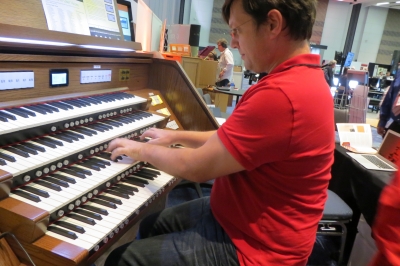
David trying out an organ at NAMM 2015.
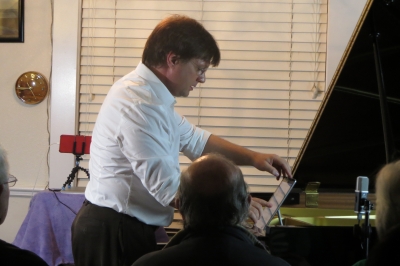
Setting up for the house concert at Kathy's. March 2015.
KP: What was the inspiration for “Incantation”?
DH: “Incantation” is the first and only piece that I ever heard in my head before writing it. The introductory repeated note with its syncopated rhythm is something that plagued me for months until I decided to work on it. I had a lot of fun working on it, and had so many ideas that it turned into a rather long piece. When I first started playing it, it was a disaster, and I really had to practice it a lot to get it up to speed. It is not a particularly difficult piece, but it does require a lot of stamina in the left hand.
KP: Stories of You is much softer and more romantic. Were you intentionally keeping your bigger and more dramatic music separate from the quieter music? Or was it more in keeping with the themes of the two albums?
DH: Stories of You is all about romance, and the more dramatic pieces just wouldn’t have worked on that album. I had not yet fully developed the ideas for The Art Of Piano, so in many ways, Stories of You is a continuation of Goddess, Angels and Faeries, despite the fact that my style has evolved considerably.
KP: “Kaiaka Bay” has been through several incarnations and on the album it is a piano solo. Why all of the changes? It’s such a beautiful piece!
DH: Kaiaka Bay is a beautiful bay that was situated just behind my studio in Hawaii. It is where “The Bell Carol” video was filmed, and much of the inspiration for Goddess, Angels and Faeries came from looking at that view every day. The piece “Kaiaka Bay” began as a work for piano and cello, but was later changed for two pianos in order to film another video in Hawaii. The piece evolved into something bigger with strings and Hawaiian chanting, but as much as I liked the arrangement, it was no longer playable by one pianist. I decided to resurrect the piece by incorporating both piano parts into a solo, which involves some crossing of hands. The piano solo has exposed it to a much larger audience than the original arrangement would have.
KP: You also recently released a piano duet called “Gemini.” I’m hoping I can work on it with a couple of my more advanced students. It’s a wonderful duet! What was the idea behind that piece?

David, Anna, and David's mother, Thelma.
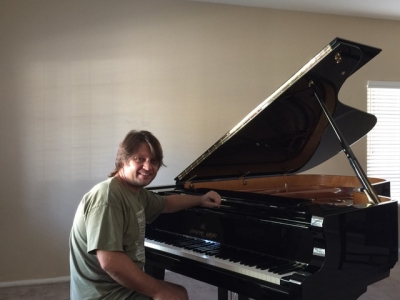
David and Camille!
DH: I have received emails from many piano teachers throughout the world saying how much their students enjoy my pieces. It appears that many of their students are more interested in learning my music than the classical repertoire, which is both good and bad. A number of teachers have asked me to write duets, so after giving it some thought for a few months, I decided to write one. It was a lot of fun to compose “Gemini” because in one sense it gave me more freedom to combine different ideas using four hands, but at the same time, it was more difficult because each part is limited to a certain area of the keyboard.
KP: Do you plan to compose more duets?
DH: Yes, I plan on writing a book of twelve duets, of which “Gemini” will be one.
KP: What’s up next for you?
DH: I continue to compose every day, and have a great time doing so. I never quite know where the journey will lead, but I know that another album will be complete by July or August, and I plan on releasing another Christmas album at the end of the year. You can expect to hear pieces with more orchestration, as well as contemporary sounds. I have a series of new books in the works including Music Theory for Pianists and How to Make a Living as a Pianist.
KP: And making lots of videos!
DH: There will certainly be lots of videos, some of which will be filmed in spectacular locations.
KP: Is there anything you’d like to talk about?
DH: In October 2015, I was proud to become a Shigeru Kawai Artist. At one point, I owned four pianos, all of which are featured in my videos, and I decided that life would be much easier with just one fantastic piano. I already owned a new Steinway model O which was featured in “The Bell Carol,” but when I discovered Shigeru Kawai, I felt that it was the best piano that I had ever played. The main reason for this is the carbon fiber action. For me, the feel of a piano is more important than anything, and the action of this piano allows me to connect with the strings in ways that I never could before. I have an SK-7 semi concert grand which is 7’ 6” and even has a name… “Camille.”
KP: How did you come up with the name?
DH: I’ve always liked the name, and it was my grandmother’s favorite movie from 1937 starring Greta Garbo.
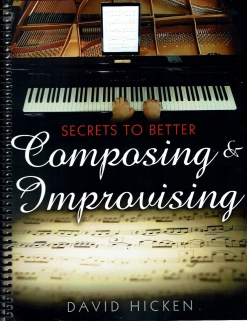
Click on cover to go to Kathy's review.
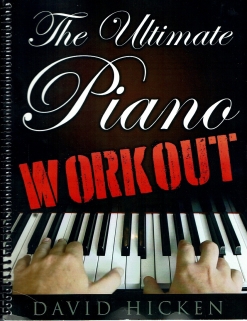
Click on cover to go to Kathy's review.
Many thanks to David Hicken for taking time to chat and for bringing us up-to-date! For more information about David and his music, be sure to visit
his website and
Artist Page here on MainlyPiano.com.
Kathy Parsons
March 2017

